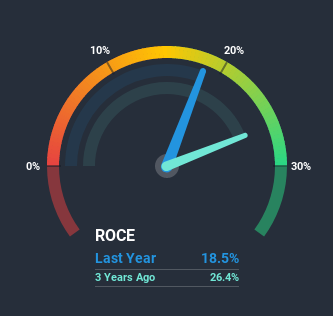Here's What To Make Of Anexo Group's (LON:ANX) Returns On Capital

To find a multi-bagger stock, what are the underlying trends we should look for in a business? Ideally, a business will show two trends; firstly a growing return on capital employed (ROCE) and secondly, an increasing amount of capital employed. This shows us that it's a compounding machine, able to continually reinvest its earnings back into the business and generate higher returns. However, after briefly looking over the numbers, we don't think Anexo Group (LON:ANX) has the makings of a multi-bagger going forward, but let's have a look at why that may be.
What is Return On Capital Employed (ROCE)?
For those who don't know, ROCE is a measure of a company's yearly pre-tax profit (its return), relative to the capital employed in the business. Analysts use this formula to calculate it for Anexo Group:
Return on Capital Employed = Earnings Before Interest and Tax (EBIT) ÷ (Total Assets - Current Liabilities)
0.18 = UK£21m ÷ (UK£155m - UK£43m) (Based on the trailing twelve months to June 2020).
So, Anexo Group has an ROCE of 18%. In absolute terms, that's a pretty normal return, and it's somewhat close to the Consumer Services industry average of 17%.
Check out our latest analysis for Anexo Group
In the above chart we have measured Anexo Group's prior ROCE against its prior performance, but the future is arguably more important. If you'd like, you can check out the forecasts from the analysts covering Anexo Group here for free.
What Does the ROCE Trend For Anexo Group Tell Us?
The trend of ROCE doesn't look fantastic because it's fallen from 31% four years ago, while the business's capital employed increased by 163%. Usually this isn't ideal, but given Anexo Group conducted a capital raising before their most recent earnings announcement, that would've likely contributed, at least partially, to the increased capital employed figure. The funds raised likely haven't been put to work yet so it's worth watching what happens in the future with Anexo Group's earnings and if they change as a result from the capital raise. Additionally, we found that Anexo Group's most recent EBIT figure is around the same as the prior year, so we'd attribute the drop in ROCE mostly to the capital raise.
What We Can Learn From Anexo Group's ROCE
In summary, despite lower returns in the short term, we're encouraged to see that Anexo Group is reinvesting for growth and has higher sales as a result. And there could be an opportunity here if other metrics look good too, because the stock has declined 33% in the last year. As a result, we'd recommend researching this stock further to uncover what other fundamentals of the business can show us.
One more thing to note, we've identified 1 warning sign with Anexo Group and understanding it should be part of your investment process.
For those who like to invest in solid companies, check out this free list of companies with solid balance sheets and high returns on equity.
This article by Simply Wall St is general in nature. It does not constitute a recommendation to buy or sell any stock, and does not take account of your objectives, or your financial situation. We aim to bring you long-term focused analysis driven by fundamental data. Note that our analysis may not factor in the latest price-sensitive company announcements or qualitative material. Simply Wall St has no position in any stocks mentioned.
Have feedback on this article? Concerned about the content? Get in touch with us directly. Alternatively, email editorial-team@simplywallst.com.


